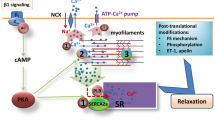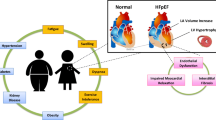Abstract
Coronary artery disease is present in 40–55% of patients with diastolic heart failure, and myocardial ischemia is both a cause and a precipitant of diastolic heart failure. Failure to recognize and treat acute and chronic ischemia in patients with this disorder results in rapid disease progression and poor outcomes. In diastolic heart failure patients without obstructive coronary artery disease, ischemia can be induced by other diseases that diminish perfusion gradient, cause myocardium to outgrow blood supply, or decrease diastolic filling time. In this article, we review the role of ischemia and development of fibrosis in the epidemiology, pathophysiology, and evaluation of patients with diastolic dysfunction and diastolic heart failure.

Similar content being viewed by others
References
Papers of particular interest, published recently, have been highlighted as: • Of importance •• Of major importance
• Yancy CW, Lopatin M, Stevenson LW, et al.: Clinical presentation, management, and in-hospital outcomes of patients admitted with acute decompensated heart failure with preserved systolic function: a report from the Acute Decompensated Heart Failure National Registry (ADHERE) Database. J Am Coll Cardiol 2006, 47:76–84. This provides registry data on incidence of DHF and ischemia.
Zile MR, Brutsaert DL: New concepts in diastolic dysfunction and diastolic heart failure: Part II: causal mechanisms and treatment. Circulation 2002, 105:1503–1508.
•• Jessup M, Abraham WT, Casey DE, et al.: 2009 focused update: ACCF/AHA Guidelines for the Diagnosis and Management of Heart Failure in Adults: a report of the American College of Cardiology Foundation/American Heart Association Task Force on Practice Guidelines: developed in collaboration with the International Society for Heart and Lung Transplantation. Circulation 2009, 119:1977–2016. These are the latest guidelines on treatment of patients with HF.
Ishii K, Suyama T, Imai M, et al.: Abnormal regional left ventricular systolic and diastolic function in patients with coronary artery disease undergoing percutaneous coronary intervention: clinical significance of post-ischemic diastolic stunning. J Am Coll Cardiol 2009, 54:1589–1597.
Khand AU, Gemmell I, Rankin AC, Cleland JG: Clinical events leading to the progression of heart failure: insights from a national database of hospital discharges. Eur Heart J 2001, 22:153–164.
Yusuf S, Pfeffer MA, Swedberg K, et al.: Effects of candesartan in patients with chronic heart failure and preserved left-ventricular ejection fraction: the CHARM-Preserved Trial. Lancet 2003, 362:777–781.
McMurray JJ, Ostergren J, Swedberg K, et al.: Effects of candesartan in patients with chronic heart failure and reduced left-ventricular systolic function taking angiotensin-converting-enzyme inhibitors: the CHARM-Added trial. Lancet 2003, 362:767–771.
Persson H, Lonn E, Edner M, et al.: Diastolic dysfunction in heart failure with preserved systolic function: need for objective evidence: results from the CHARM Echocardiographic Substudy-CHARMES. J Am Coll Cardiol 2007, 49:687–694.
Fonarow GC, Stough WG, Abraham WT, et al.: Characteristics, treatments, and outcomes of patients with preserved systolic function hospitalized for heart failure: a report from the OPTIMIZE-HF Registry. J Am Coll Cardiol 2007, 50:768–777.
Bhatia RS, Tu JV, Lee DS, et al.: Outcome of heart failure with preserved ejection fraction in a population-based study. N Engl J Med 2006, 355:260–269.
Gheorghiade M, Abraham WT, Albert NM, et al.: Systolic blood pressure at admission, clinical characteristics, and outcomes in patients hospitalized with acute heart failure. JAMA 2006, 296:2217–2226.
Tribouilloy C, Rusinaru D, Mahjoub H, et al.: Prognosis of heart failure with preserved ejection fraction: a 5 year prospective population-based study. Eur Heart J 2008, 29:339–347.
Gotsman I, Zwas D, Planer D, et al.: Clinical outcome of patients with heart failure and preserved left ventricular function. Am J Med 2008, 121:997–1001.
Peltier M, Houpe D, Cohen-Solal A, et al.: Treatment practices in heart failure with preserved left ventricular ejection fraction: a prospective observational study. Int J Cardiol 2007, 118:363–369.
Soman P, Lahiri A, Mieres JH, et al.: Etiology and pathophysiology of new-onset heart failure: evaluation by myocardial perfusion imaging. J Nucl Cardiol 2009, 16:82–91.
Olivotto I, Cecchi F, Gistri R, et al.: Relevance of coronary microvascular flow impairment to long-term remodeling and systolic dysfunction in hypertrophic cardiomyopathy. J Am Coll Cardiol 2006, 47:1043–1048.
Yoshida N, Ikeda H, Wada T, et al.: Exercise-induced abnormal blood pressure responses are related to subendocardial ischemia in hypertrophic cardiomyopathy. J Am Coll Cardiol 1998, 32:1938–1942.
Maron MS, Appelbaum E, Harrigan CJ, et al.: Clinical profile and significance of delayed enhancement in hypertrophic cardiomyopathy. Circ Heart Fail 2008, 1:184–191.
•• Maron MS, Olivotto I, Maron BJ, et al.: The case for myocardial ischemia in hypertrophic cardiomyopathy. J Am Coll Cardiol 2009, 54:866–875. This is a description of similar findings in patients with HCM and DHF.
Zile MR, Brutsaert DL: New concepts in diastolic dysfunction and diastolic heart failure: Part I: diagnosis, prognosis, and measurements of diastolic function. Circulation 2002, 105:1387–1393.
Shah AM, Silverman HS, Griffiths EJ, et al.: cGMP prevents delayed relaxation at reoxygenation after brief hypoxia in isolated cardiac myocytes. Am J Physiol 1995, 268:H2396–H2204.
Paulus WJ, Vantrimpont PJ, Shah AM: Acute effects of nitric oxide on left ventricular relaxation and diastolic distensibility in humans. Assessment by bicoronary sodium nitroprusside infusion. Circulation 1994, 89:2070–2078.
Bonow RO, Bacharach SL, Green MV, et al.: Impaired left ventricular diastolic filling in patients with coronary artery disease: assessment with radionuclide angiography. Circulation 1981, 64:315–323.
Carroll JD, Hess OM, Hirzel HO, et al.: Left ventricular systolic and diastolic function in coronary artery disease: effects of revascularization on exercise-induced ischemia. Circulation 1985, 72:119–129.
Hutchins GM, Silverman KJ: Pathology of the stone heart syndrome. Massive myocardial contraction band necrosis and widely patent coronary arteries. Am J Pathol 1979, 95:745–752.
Wukasch DC, Reul GJ, Milam JD, et al.: The “stone heart” syndrome. Surgery 1972, 72:1071–1080.
Wexler LF, Weinberg EO, Ingwall JS, Apstein CS: Acute alterations in diastolic left ventricular chamber distensibility: mechanistic differences between hypoxemia and ischemia in isolated perfused rabbit and rat hearts. Circ Res 1986, 59:515–528.
Smalling RW, Kelley KO, Kirkeeide RL, Gould KL: Comparison of early systolic and early diastolic regional function during regional ischemia in a chronically instrumented canine model. J Am Coll Cardiol 1983, 2:263–269.
He KL, Dickstein M, Sabbah HN, et al.: Mechanisms of heart failure with well preserved ejection fraction in dogs following limited coronary microembolization. Cardiovasc Res 2004, 64:72–83.
Wang J, Nagueh SF: Current perspectives on cardiac function in patients with diastolic heart failure. Circulation 2009, 119:1146–1157.
Abraham TP, Belohlavek M, Thomson HL, et al.: Time to onset of regional relaxation: feasibility, variability and utility of a novel index of regional myocardial function by strain rate imaging. J Am Coll Cardiol 2002, 39:1531–1537.
Voigt JU, Exner B, Schmiedehausen K, et al.: Strain-rate imaging during dobutamine stress echocardiography provides objective evidence of inducible ischemia. Circulation 2003, 107:2120–2126.
Ishii K, Imai M, Suyama T, et al.: Exercise-induced post-ischemic left ventricular delayed relaxation or diastolic stunning: is it a reliable marker in detecting coronary artery disease? J Am Coll Cardiol 2009, 53:698–705.
Azevedo CF, Amado LC, Kraitchman DL, et al.: Persistent diastolic dysfunction despite complete systolic functional recovery after reperfused acute myocardial infarction demonstrated by tagged magnetic resonance imaging. Eur Heart J 2004, 25:1419–1427.
Vinereanu D, Fraser AG, Robinson M, et al.: Adenosine provokes diastolic dysfunction in microvascular angina. Postgrad Med J 2002, 78:40–42.
Derumeaux G, Ovize M, Loufoua J, et al.: Doppler tissue imaging quantitates regional wall motion during myocardial ischemia and reperfusion. Circulation 1998, 97:1970–1977.
•• Martos R, Baugh J, Ledwidge M, et al.: Diastolic heart failure: evidence of increased myocardial collagen turnover linked to diastolic dysfunction. Circulation 2007, 115:888–895. This is a report on collagen turnover and diastolic dysfunction.
Asanuma T, Uranishi A, Masuda K, et al.: Assessment of myocardial ischemic memory using persistence of post-systolic thickening after recovery from ischemia. JACC Cardiovasc Imaging 2009, 2:1253–1261.
Wilson RM, De Silva DS, Sato K, et al.: Effects of fixed-dose isosorbide dinitrate/hydralazine on diastolic function and exercise capacity in hypertension-induced diastolic heart failure. Hypertension 2009, 54:583–590.
Belardinelli L, Shryock JC, Fraser H: Inhibition of the late sodium current as a potential cardioprotective principle: effects of the late sodium current inhibitor ranolazine. Heart 2006, 92(Suppl 4):iv6–iv14.
Fraser H, Belardinelli L, Wang L, et al.: Ranolazine decreases diastolic calcium accumulation caused by ATX-II or ischemia in rat hearts. J Mol Cell Cardiol 2006, 41:1031–1038.
Fukuta H, Sane DC, Brucks S, Little WC: Statin therapy may be associated with lower mortality in patients with diastolic heart failure: a preliminary report. Circulation 2005, 112:357–363.
ClinicalTrials.gov: Aldosterone Antagonist Therapy for Adults With Heart Failure and Preserved Systolic Function (TOPCAT) Clinical Trial Summary. Available at http://clinicaltrials.gov/ct2/show/NCT00094302. Accessed February 2010.
•• de Boer RA, Voors AA, Muntendam P, et al.: Galectin-3: a novel mediator of heart failure development and progression. Eur J Heart Fail 2009, 11:811–817. This is a review of galectin-3, a novel biomarker of fibrosis in HF.
Urano H, Ikeda H, Ueno T, et al.: Enhanced external counterpulsation improves exercise tolerance, reduces exercise-induced myocardial ischemia and improves left ventricular diastolic filling in patients with coronary artery disease. J Am Coll Cardiol 2001, 37:93–99.
Schneider C, Jaquet K, Geidel S, et al.: Transplantation of bone marrow-derived stem cells improves myocardial diastolic function: strain rate imaging in a model of hibernating myocardium. J Am Soc Echocardiogr 2009, 22:1180–1189.
Hedman A, Samad BA, Larsson T, et al.: Improvement in diastolic left ventricular function after coronary artery bypass grafting as assessed by recordings of mitral annular velocity using Doppler tissue imaging. Eur J Echocardiogr 2005, 6:202–209.
el-Said ES, Fioretti PM, Roelandt JR, et al.: Dobutamine stress—Doppler echocardiography before and after coronary angioplasty. Eur Heart J 1993, 14:1011–1021.
Masoudi FA, Havranek EP, Smith G, et al.: Gender, age, and heart failure with preserved left ventricular systolic function. J Am Coll Cardiol 2003, 41:217–223.
McMurray JJ, Carson PE, Komajda M, et al.: Heart failure with preserved ejection fraction: clinical characteristics of 4133 patients enrolled in the I-PRESERVE trial. Eur J Heart Fail 2008, 10:149–156.
Owan T, Hodge D, Herges R, et al.: Trends in prevalence and outcome of heart failure with preserved ejection fraction. N Engl J Med 2006, 355:251–259.
Disclosure
No potential conflicts of interest relevant to this article were reported.
Author information
Authors and Affiliations
Corresponding author
Rights and permissions
About this article
Cite this article
Vanhecke, T.E., Kim, R., Raheem, S.Z. et al. Myocardial Ischemia in Patients with Diastolic Dysfunction and Heart Failure. Curr Cardiol Rep 12, 216–222 (2010). https://doi.org/10.1007/s11886-010-0101-1
Published:
Issue Date:
DOI: https://doi.org/10.1007/s11886-010-0101-1




